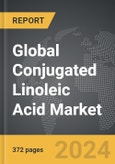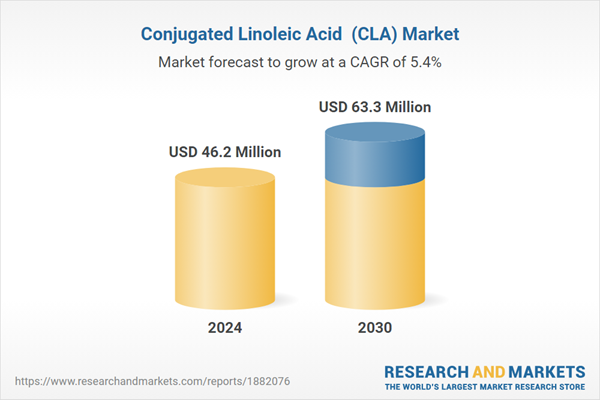The global market for Conjugated Linoleic Acid (CLA) was estimated at US$46.2 Million in 2024 and is projected to reach US$63.3 Million by 2030, growing at a CAGR of 5.4% from 2024 to 2030. This comprehensive report provides an in-depth analysis of market trends, drivers, and forecasts, helping you make informed business decisions. The report includes the most recent global tariff developments and how they impact the Conjugated Linoleic Acid (CLA) market.
The global market for CLA has experienced substantial growth, largely driven by an increasing consumer awareness of its purported health benefits and a burgeoning interest in dietary supplements and functional foods. CLA is widely available in supplement form, often marketed towards athletes and fitness enthusiasts for its potential to aid in weight management and muscle enhancement. Beyond supplements, CLA is being incorporated into a variety of food products, including fortified dairy products, snack bars, and beverages. This trend is particularly pronounced in North America and Europe, regions where consumers are highly health-conscious and more inclined to invest in functional foods that offer specific health benefits. Additionally, advancements in production technologies have played a critical role in this market expansion. Modern extraction and synthesis techniques have made it possible to produce high-purity CLA more efficiently and cost-effectively, thereby enhancing its market availability and appeal.
The growth in the CLA market is driven by several factors. Technological advancements in the extraction and synthesis of CLA have significantly reduced production costs while improving the quality and consistency of the final product. This has made CLA more accessible and appealing to a broader range of consumers and manufacturers. Furthermore, the range of end-use applications for CLA has expanded considerably. It is now incorporated into an increasing variety of food and beverage products, dietary supplements, and even animal feed, reflecting its versatility and broad consumer appeal. Consumer behavior trends also play a pivotal role in driving market growth. There is a rising interest in natural and functional foods, as people are increasingly looking for products that offer health benefits beyond basic nutrition. CLA fits perfectly into this demand, particularly as lifestyle-related health issues such as obesity and diabetes become more prevalent. These conditions have heightened consumer interest in products that can help manage or mitigate their effects. Moreover, regulatory endorsements and scientifically substantiated health claims have bolstered consumer confidence, further driving market expansion. This growing body of evidence supporting CLA`s health benefits, combined with strategic marketing and product innovation, has positioned CLA as a key player in the health and wellness industry.
Conjugated Linoleic Acid (CLA) - Key Trends and Drivers
Conjugated Linoleic Acid (CLA) is a type of polyunsaturated fatty acid predominantly found in the meat and dairy products of ruminant animals like cows, sheep, and goats. CLA consists of a group of isomers of linoleic acid, distinguished by their unique arrangement of double bonds. The most common isomers, cis-9, trans-11 and trans-10, cis-12, have been extensively studied for their potential health benefits. Research indicates that CLA can play a significant role in reducing body fat, improving lean muscle mass, and potentially lowering the risk of certain cancers. Additionally, CLA has been observed to enhance immune function and exert anti-inflammatory effects, which may contribute to the management of metabolic disorders such as diabetes. Despite these promising findings, the exact mechanisms by which CLA exerts these benefits remain a topic of ongoing scientific investigation. It`s also important to note that most of the research has been conducted in animal models, and human studies have shown mixed results, indicating the need for further research to conclusively determine the efficacy and safety of CLA supplementation.The global market for CLA has experienced substantial growth, largely driven by an increasing consumer awareness of its purported health benefits and a burgeoning interest in dietary supplements and functional foods. CLA is widely available in supplement form, often marketed towards athletes and fitness enthusiasts for its potential to aid in weight management and muscle enhancement. Beyond supplements, CLA is being incorporated into a variety of food products, including fortified dairy products, snack bars, and beverages. This trend is particularly pronounced in North America and Europe, regions where consumers are highly health-conscious and more inclined to invest in functional foods that offer specific health benefits. Additionally, advancements in production technologies have played a critical role in this market expansion. Modern extraction and synthesis techniques have made it possible to produce high-purity CLA more efficiently and cost-effectively, thereby enhancing its market availability and appeal.
The growth in the CLA market is driven by several factors. Technological advancements in the extraction and synthesis of CLA have significantly reduced production costs while improving the quality and consistency of the final product. This has made CLA more accessible and appealing to a broader range of consumers and manufacturers. Furthermore, the range of end-use applications for CLA has expanded considerably. It is now incorporated into an increasing variety of food and beverage products, dietary supplements, and even animal feed, reflecting its versatility and broad consumer appeal. Consumer behavior trends also play a pivotal role in driving market growth. There is a rising interest in natural and functional foods, as people are increasingly looking for products that offer health benefits beyond basic nutrition. CLA fits perfectly into this demand, particularly as lifestyle-related health issues such as obesity and diabetes become more prevalent. These conditions have heightened consumer interest in products that can help manage or mitigate their effects. Moreover, regulatory endorsements and scientifically substantiated health claims have bolstered consumer confidence, further driving market expansion. This growing body of evidence supporting CLA`s health benefits, combined with strategic marketing and product innovation, has positioned CLA as a key player in the health and wellness industry.
Scope of Study:
The report analyzes the Conjugated Linoleic Acid (CLA) market in terms of units by the following Segments, and Geographic Regions/Countries:- Segments: Application (Dietary Supplements, Food & Beverages, Pharmaceuticals, Animal Feeds, Other Applications)
- Geographic Regions/Countries: World; United States; Canada; Japan; China; Europe (France; Germany; Italy; United Kingdom; Spain; Russia; and Rest of Europe); Asia-Pacific (Australia; India; South Korea; and Rest of Asia-Pacific); Latin America (Argentina; Brazil; Mexico; and Rest of Latin America); Middle East (Iran; Israel; Saudi Arabia; United Arab Emirates; and Rest of Middle East); and Africa.
Key Insights:
- Market Growth: Understand the significant growth trajectory of the Dietary Supplements segment, which is expected to reach US$30.6 Million by 2030 with a CAGR of a 6.2%. The Food & Beverages segment is also set to grow at 5.4% CAGR over the analysis period.
- Regional Analysis: Gain insights into the U.S. market, estimated at $12.3 Million in 2024, and China, forecasted to grow at an impressive 9.1% CAGR to reach $14.1 Million by 2030. Discover growth trends in other key regions, including Japan, Canada, Germany, and the Asia-Pacific.
Why You Should Buy This Report:
- Detailed Market Analysis: Access a thorough analysis of the Global Conjugated Linoleic Acid (CLA) Market, covering all major geographic regions and market segments.
- Competitive Insights: Get an overview of the competitive landscape, including the market presence of major players across different geographies.
- Future Trends and Drivers: Understand the key trends and drivers shaping the future of the Global Conjugated Linoleic Acid (CLA) Market.
- Actionable Insights: Benefit from actionable insights that can help you identify new revenue opportunities and make strategic business decisions.
Key Questions Answered:
- How is the Global Conjugated Linoleic Acid (CLA) Market expected to evolve by 2030?
- What are the main drivers and restraints affecting the market?
- Which market segments will grow the most over the forecast period?
- How will market shares for different regions and segments change by 2030?
- Who are the leading players in the market, and what are their prospects?
Report Features:
- Comprehensive Market Data: Independent analysis of annual sales and market forecasts in US$ Million from 2024 to 2030.
- In-Depth Regional Analysis: Detailed insights into key markets, including the U.S., China, Japan, Canada, Europe, Asia-Pacific, Latin America, Middle East, and Africa.
- Company Profiles: Coverage of players such as BASF SE, Eastman Chemical Company, INNOBIO, Jarrow Formulas, Inc., Metagenics, Inc. and more.
- Complimentary Updates: Receive free report updates for one year to keep you informed of the latest market developments.
Some of the 39 companies featured in this Conjugated Linoleic Acid (CLA) market report include:
- BASF SE
- Eastman Chemical Company
- INNOBIO
- Jarrow Formulas, Inc.
- Metagenics, Inc.
- Nature's Sunshine Products, Inc.
- Nature's Way Products, Inc.
- Reflex Nutrition Ltd.
- Stepan Company
This edition integrates the latest global trade and economic shifts as of June 2025 into comprehensive market analysis. Key updates include:
- Tariff and Trade Impact: Insights into global tariff negotiations across 180+ countries, with analysis of supply chain turbulence, sourcing disruptions, and geographic realignment. Special focus on 2025 as a pivotal year for trade tensions, including updated perspectives on the Trump-era tariffs.
- Adjusted Forecasts and Analytics: Revised global and regional market forecasts through 2030, incorporating tariff effects, economic uncertainty, and structural changes in globalization. Includes segmentation by product, technology, type, material, distribution channel, application, and end-use, with historical analysis since 2015.
- Strategic Market Dynamics: Evaluation of revised market prospects, regional outlooks, and key economic indicators such as population and urbanization trends.
- Innovation & Technology Trends: Latest developments in product and process innovation, emerging technologies, and key industry drivers shaping the competitive landscape.
- Competitive Intelligence: Updated global market share estimates for 2025, competitive positioning of major players (Strong/Active/Niche/Trivial), and refined focus on leading global brands and core players.
- Expert Insight & Commentary: Strategic analysis from economists, trade experts, and domain specialists to contextualize market shifts and identify emerging opportunities.
- Complimentary Update: Buyers receive a free July 2025 update with finalized tariff impacts, new trade agreement effects, revised projections, and expanded country-level coverage.
Table of Contents
I. METHODOLOGYII. EXECUTIVE SUMMARY2. FOCUS ON SELECT PLAYERSIV. COMPETITION
1. MARKET OVERVIEW
3. MARKET TRENDS & DRIVERS
4. GLOBAL MARKET PERSPECTIVE
III. MARKET ANALYSIS
Companies Mentioned (Partial List)
A selection of companies mentioned in this report includes, but is not limited to:
- BASF SE
- Eastman Chemical Company
- INNOBIO
- Jarrow Formulas, Inc.
- Metagenics, Inc.
- Nature's Sunshine Products, Inc.
- Nature's Way Products, Inc.
- Reflex Nutrition Ltd.
- Stepan Company
Table Information
| Report Attribute | Details |
|---|---|
| No. of Pages | 372 |
| Published | July 2025 |
| Forecast Period | 2024 - 2030 |
| Estimated Market Value ( USD | $ 46.2 Million |
| Forecasted Market Value ( USD | $ 63.3 Million |
| Compound Annual Growth Rate | 5.4% |
| Regions Covered | Global |









